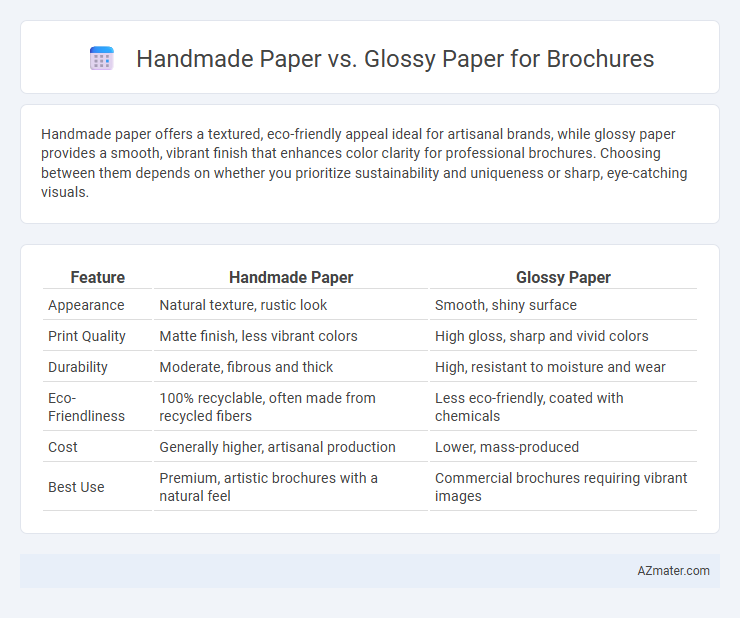Handmade paper offers a textured, eco-friendly appeal ideal for artisanal brands, while glossy paper provides a smooth, vibrant finish that enhances color clarity for professional brochures. Choosing between them depends on whether you prioritize sustainability and uniqueness or sharp, eye-catching visuals.
Table of Comparison
| Feature | Handmade Paper | Glossy Paper |
|---|---|---|
| Appearance | Natural texture, rustic look | Smooth, shiny surface |
| Print Quality | Matte finish, less vibrant colors | High gloss, sharp and vivid colors |
| Durability | Moderate, fibrous and thick | High, resistant to moisture and wear |
| Eco-Friendliness | 100% recyclable, often made from recycled fibers | Less eco-friendly, coated with chemicals |
| Cost | Generally higher, artisanal production | Lower, mass-produced |
| Best Use | Premium, artistic brochures with a natural feel | Commercial brochures requiring vibrant images |
Introduction to Handmade and Glossy Papers
Handmade paper is crafted using traditional methods involving natural fibers like cotton or recycled materials, resulting in a textured, eco-friendly surface with unique, organic patterns ideal for artisanal or luxury brochures. Glossy paper, coated with a smooth, reflective finish, enhances color vibrancy and sharpness, making it perfect for high-impact, visually-driven marketing materials. Choosing between handmade and glossy paper depends on the desired aesthetic, tactile experience, and brand positioning of the brochure.
Key Differences Between Handmade and Glossy Paper
Handmade paper features a textured, fibrous surface created through traditional methods, offering a unique, artisanal appearance ideal for eco-friendly and luxury brochures. Glossy paper is smooth, coated with a shiny finish that enhances color vibrancy and sharp image quality, making it suitable for high-impact marketing materials. Key differences include durability, visual appeal, and tactile experience, with handmade paper emphasizing natural aesthetics and glossy paper prioritizing vivid, professional presentation.
Environmental Impact: Sustainability Considerations
Handmade paper is highly sustainable due to its eco-friendly production process, often using recycled fibers and minimal chemicals, which reduces environmental pollution and conserves natural resources. In contrast, glossy paper typically involves chemical coatings and non-recyclable components, contributing to greater environmental harm and landfill waste. Choosing handmade paper for brochures supports sustainability goals by minimizing carbon footprint and promoting biodegradable waste.
Texture and Visual Appeal Comparison
Handmade paper offers a unique, tactile texture with natural fibers and an organic finish that enhances the sensory experience of brochures, making them stand out with a warm, artisanal appearance. Glossy paper provides a smooth, reflective surface that intensifies color vibrancy and sharpness, resulting in a polished and professional look ideal for high-impact visual graphics. Choosing between handmade and glossy paper depends on whether the goal is to convey authenticity and craftsmanship or to achieve sleek, vivid imagery.
Printing Quality and Color Vibrancy
Handmade paper offers a unique texture that enhances the tactile experience but can slightly diffuse ink, potentially reducing printing sharpness and precise color vibrancy in brochures. Glossy paper provides a smooth, reflective surface that maximizes ink adhesion and color saturation, resulting in sharper images and brighter, more vivid colors. For high-impact brochures with vibrant visuals, glossy paper generally outperforms handmade paper in printing quality and color intensity.
Durability and Longevity of Brochures
Handmade paper offers superior durability due to its fibrous, textured composition that resists tearing and wear, making it ideal for brochures intended to last. Glossy paper, while visually striking with its smooth, reflective surface, tends to be prone to scratching and can degrade faster under frequent handling or exposure to moisture. Choosing handmade paper enhances brochure longevity, preserving print quality and structural integrity over time compared to glossy finishes.
Cost Comparison: Budgeting for Your Brochure
Handmade paper for brochures typically costs more due to its artisanal production process and unique texture, making it ideal for luxury or niche branding but less feasible for large print runs. Glossy paper offers a more economical solution, providing vibrant colors and a smooth finish at a lower price point, suitable for mass distribution and budget-conscious projects. When budgeting for your brochure, balance cost against the desired visual impact and target audience, with handmade paper elevating perceived value while glossy paper maximizes affordability.
Brand Image and Audience Perception
Handmade paper conveys an artisanal, eco-friendly brand image that appeals to audiences valuing sustainability and uniqueness, enhancing emotional connection and perceived authenticity. Glossy paper exudes professionalism and modernity, attracting audiences who associate sleek, vibrant visuals with quality and innovation. Choosing between these paper types influences brand positioning and effectively targets specific consumer preferences and expectations.
Ideal Use Cases for Each Paper Type
Handmade paper is ideal for eco-friendly or artisanal brands seeking a textured, rustic look that conveys authenticity and craftsmanship, making it perfect for luxury invitations, boutique catalogs, or artistic portfolios. Glossy paper enhances color vibrancy and sharpness, making it best suited for high-impact marketing materials such as product brochures, event flyers, and photo-rich catalogs where visual appeal and durability are crucial. Choosing between handmade and glossy paper depends on whether the brochure emphasizes tactile uniqueness or vivid, polished imagery to effectively communicate the brand message.
Choosing the Right Paper for Your Next Brochure
Handmade paper offers a unique, textured finish that enhances the tactile experience and conveys an artisanal, eco-friendly brand image, ideal for boutique or luxury brochures. Glossy paper delivers vibrant color reproduction and sharp detail, making it perfect for visually driven marketing materials needing a polished, professional look. Selecting the right paper depends on your brand identity, target audience, and the desired visual impact for maximum engagement.

Infographic: Handmade paper vs Glossy paper for Brochure
 azmater.com
azmater.com